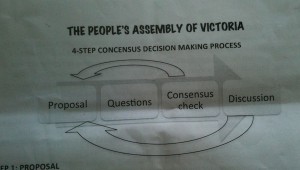I was extremely privileged to help facilitate, along with Ross Laird and Brian Williams, a session on mindfulness and technology at last month’s Fall ETUG gathering at Kwantlen College in Richmond B.C. We did the session in three parts; Brian opened with a guided meditation, which Ross followed with a wonderful drawing exercise that asked people to depict their centered selves and then additionally the way they felt technology related to this self. The results of these drawings and starting the day this way was quite special and we got lots of positive feedback from participants for this novel beginning to an ed tech gathering.
For my part, I followed up these two great facilitators by leading a bit of a discussion about our relationship to technology, its effects on mindfulness and attention, ways we can cultivate mindfulness in the face of distraction, and even ways in which technology itself might be used to help improve our attention and mindfulness.
 It was in the context of this last point that I made mention of Buddhify, an iphone (and android) app I had only been made aware of, via a tweet by openbuddha, the day before. So when I mentioned it I had only had a single day to try it and wasn’t able to endorse it too vigorously, though it did already feel like something that could be useful for folks.
It was in the context of this last point that I made mention of Buddhify, an iphone (and android) app I had only been made aware of, via a tweet by openbuddha, the day before. So when I mentioned it I had only had a single day to try it and wasn’t able to endorse it too vigorously, though it did already feel like something that could be useful for folks.
Well, a month later I have had a much better chance to give Buddhify a whirl and unreservedly can say that for the novice/beginner to meditation, it might be the best $2.99 they could spend. The main component of Buddhify is a collection of guided meditations (the male voice, which I have it set to, provided by the mellifluous founder Rohan Gunatillake, but a nice touch is there is a female version too.) Now guided meditations are nothing new, you can find many good ones for free all over the internet, and I often recommend to people who are completely new to meditation or who claim they have tried but “can’t meditate” to start with a guided meditation. Not only can it be a gentler introduction, there are often lots of good tips and encouragements to help you through common frustrations. Buddhify is no different in this regard; the instructions will be very familiar to seasoned meditators, and I really appreciate the light-heartedness of Rohan’s laugh when he recognizes some of these common struggles we all face.
 But this is where Buddhify has something extra going for it, actually a couple of things. The first is that it is explicitly built to be a mobile app that recognizes the various different contexts people generally have their phones in. So at the start of the session, it asks you to select one of four settings in which you are using it – Walking, Traveling, At the Gym and finally At Home. It further contextualizes the guided meditation you’ll be offered by asking you to select what you’d like the focus of that session to be – Clarity, Connection, Stability or Embodiment. Based on your choice you’re offered a guided meditation, typically 15 minutes or so, that fits with the context.
But this is where Buddhify has something extra going for it, actually a couple of things. The first is that it is explicitly built to be a mobile app that recognizes the various different contexts people generally have their phones in. So at the start of the session, it asks you to select one of four settings in which you are using it – Walking, Traveling, At the Gym and finally At Home. It further contextualizes the guided meditation you’ll be offered by asking you to select what you’d like the focus of that session to be – Clarity, Connection, Stability or Embodiment. Based on your choice you’re offered a guided meditation, typically 15 minutes or so, that fits with the context.
 Very cool. But in addition, Buddhify brings in some game-like aspects to your beginning practice; the Dashboard keeps track of the percentage of recordings you’ve listened to, how often and the longest stretch of days you’ve used it. Now ultimately, like so many things that are “good for us,” meditation is its own reward, but I think the addition of this game aspect is likely very helpful to people getting started. Just as with exercise practices, early on the tangible results might be slight and the impetus to give up strong, as who doesn’t attach to “outcomes,” and the trick with both is to just “stick with it” for a bit, until it becomes a regular thing (and surprise, surprise, the “results” start to show up too!)
Very cool. But in addition, Buddhify brings in some game-like aspects to your beginning practice; the Dashboard keeps track of the percentage of recordings you’ve listened to, how often and the longest stretch of days you’ve used it. Now ultimately, like so many things that are “good for us,” meditation is its own reward, but I think the addition of this game aspect is likely very helpful to people getting started. Just as with exercise practices, early on the tangible results might be slight and the impetus to give up strong, as who doesn’t attach to “outcomes,” and the trick with both is to just “stick with it” for a bit, until it becomes a regular thing (and surprise, surprise, the “results” start to show up too!)
In addition to the Dashboard is the Check-In feature; you check in by rating (on a non-numerical sliding scale) how you are feeling on a number of fronts like Joy, Calm, Curiosity and Balance, and the dashboard then shows you which way you are trending. Again, positive feedback that can help you acknowledge subtle effects that can be difficult to see at any one moment (as an aside, one small addition I’d love to see would be the ability to see the longer trend diagram of these.)
After the ETUG session I used buddhify pretty much solid for 2 weeks. I then found myself using it less, only because I already had a well established sitting practiced. The app is really aimed at people just starting out, I think. But that said, even people who have been sitting for a while can use a hand; while I strive to be dilligent and sit every day, I have my ups and downs too, and just this week I turned back to Buddhify (indeed that’s what prompted this post) in an effort to get myself back on track, and have really appreciated the support and encouragement it offers. (Plus I must say I am pretty intrigued to see what happens when the community unlocks the “Buddhify Mode,” another clever motivating feature that uses skillful means to exploit our curiosity for our own benefit.)
So, novice or experienced meditator, I think there’s something here for us all. I highly recommend Buddhify, and hope it can help others on their journey to mindfulness. – SWL

 It was in the context of this last point that I made mention of
It was in the context of this last point that I made mention of 




